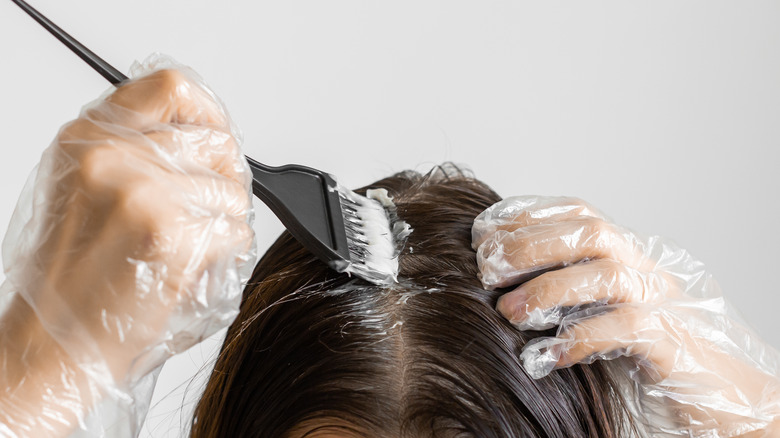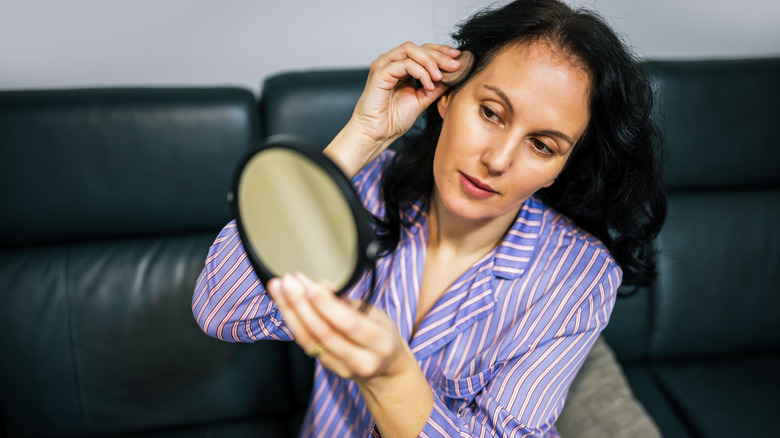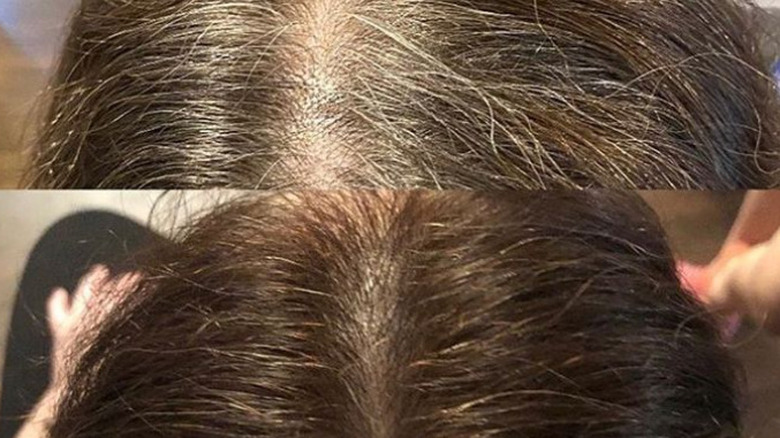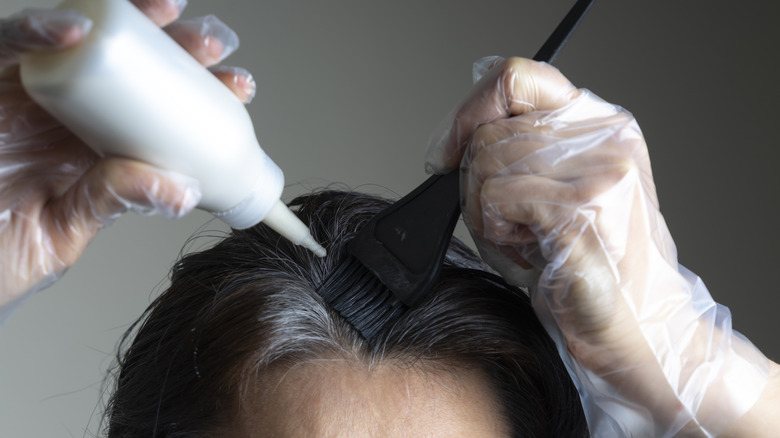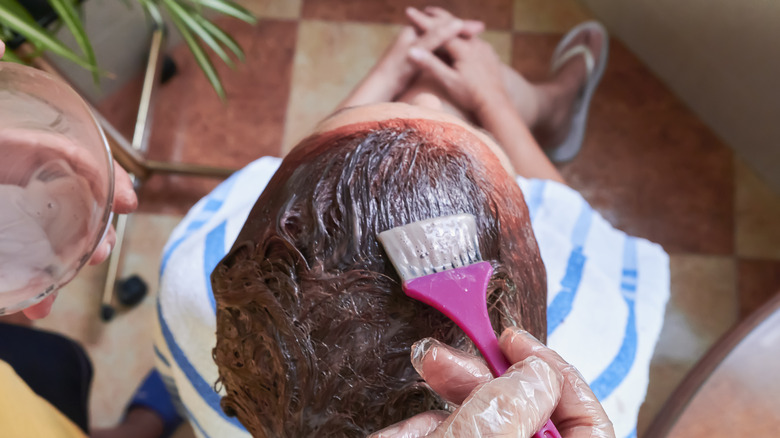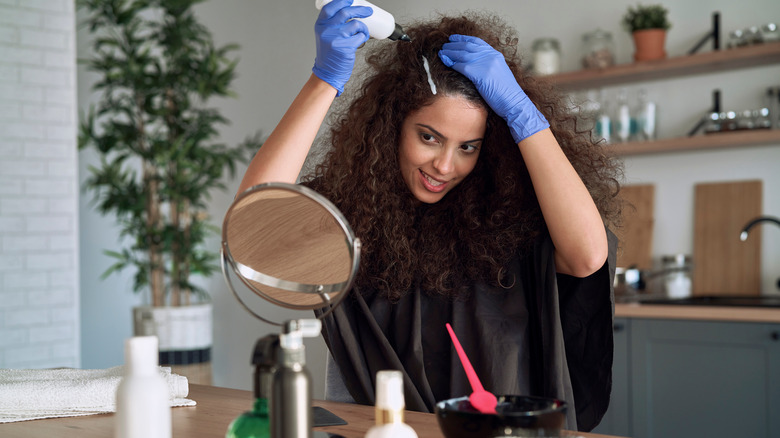Touching Up Your Roots At Home Is Easier Than You Think
We may receive a commission on purchases made from links.
Doing your hair at home can be a gamble. Granted, if you're just styling a slicked back bun or wand curling your hair, the risks are low. Once you begin introducing more in-depth techniques, such as dye jobs, you're in for a bumpy ride unless you follow directions down to a science. Root touch-ups are another trial-and-error moment, but thanks to the pros, successfully touching up roots at home is easier than ever.
Your hair will always let you know when it's time for a touch-up. As your dye job grows out, the naturally colored roots will begin to peek out from your scalp. Some stylists recommend reapplying color every six to eight weeks. Others suggest four to six weeks. It will ultimately depend on how fast your hair grows out and whether or not you can stand to look at roots that are a different hue. At-home touch-up solutions can work wonders for those on the go or anyone trying to stay on a budget.
Temporary hair dyes work wonders when in a hurry
The goal is usually to make the dye last for as long as possible. However, the morning before that big job interview or a highly-anticipated first date may not be the best time to perform a full hair upgrade. That is where temporary solutions come into play. These usually come in the form of a spray such as L'Oreal Paris Magic Root Cover Up or a powder like the Color Wow Root Coverup Powder. Though certain hair color trends may suit everyone, the perfect touch-up technique is unique to your personal needs.
Another added bonus of temporary coloring is the limited risk associated with them. With a permanent at-home dye job, there is always the risk of overprocessing or using the wrong chemicals, leaving your hair severely damaged. However, with either spray or powder for root touch-ups, there is a lower chance of hair loss.
Some temporary dyes can last longer than others
Toronto hairstylist and salon owner Jason Lee spoke with Best Health about the pros and cons of these types of remedies. Lee says these temporary pigments aren't 100% accurate, explaining, "It can make the hair appear lighter at the root." Another issue is that these fast solutions tend to come out easily when washing your hair, but for a quick touch-up before a dash out the door, these are great products to have handy.
Try hair color gel instead of powders or sprays for a longer-lasting touch-up treatment. These could prevent your hair color from washing out too fast. French color guru Christophe Robin has come up with a unique formula that can survive up to seven washes. His Temporary Color Gel features components of permanent and semi-permanent color, such as para-phenylenediamine, known as PPD. This chemical gives the dye a more natural look and prevents it from washing away.
Do your touch-ups in sections
Another celebrity hairstylist, Chris Appleton, who happens to take care of Jennifer Lopez's lustrous locks, says doing your touch-ups in sections can yield the best results. When speaking with PopSugar, Appleton explained making a "T" with the front and back allows you to dye the front of your hair with the most coverage without having to do the back. In essence, you're only dying the part of the hair that others can see. If you do intend to touch up your entire head, you can still use the "T" method. The only difference is you apply the dye to all four sections in quarter-inch areas.
When sectioning the hair, having just enough strands will ensure every piece of hair gets its due coverage. Having too much hair in each section can lead to a spotty application of the dye, something you definitely want to avoid when color treating roots.
Box dyes are different than professional hair color
One thing to keep in mind is that your professional dye job is an entirely different experience than store box color. When touching up your strands at home, you may not get the exact color that you did in the salon. Professional dye includes developers and other ingredients, which allows it to be customized. Beautician Jason Lee advised against using box dye altogether during his chat with Best Health.
He warns that touch-ups at home combined with professionally-colored hair could cause "technical problems." However, if you must tend to your roots, Lee suggests going a shade lighter when touching up darker colors. When touching up blondes or reds, you want to do the opposite because going too light in these shades can alter the entire hair color. When you need clarification on the color you're using for your root touch-up, try a patch test. Apply the shade to a small section of hair and wash it out to see if it's a match before completing your entire head.
Do not recolor your entire head
After your patch test at home, it may be tempting to color your entire head. Hair experts' views on this? Don't! Unless you've colored your hair at home before, this is not advised, especially if you've previously gotten a salon color treatment. Clairol color director James Corbett lent his expertise to Goop, pointing out that roots' base color vastly differs from the dyed part of the hair. Therefore recoloring the entire head could dull the look of your hair. DIY coloring can give you a boost of confidence, but for the sake of your tresses, stick to the roots.
While there is nothing like a salon dye job, at-home root touch-ups aren't all bad. If you need an excellent visual to follow along with, Clairol demonstrates at-home root touch-ups in a video that has attracted over 2.7 million views. Contact your stylist to walk you through the process or offer some best practices when in doubt. The results may not be perfect, but they'll certainly hold you over until your next professional dye job.
